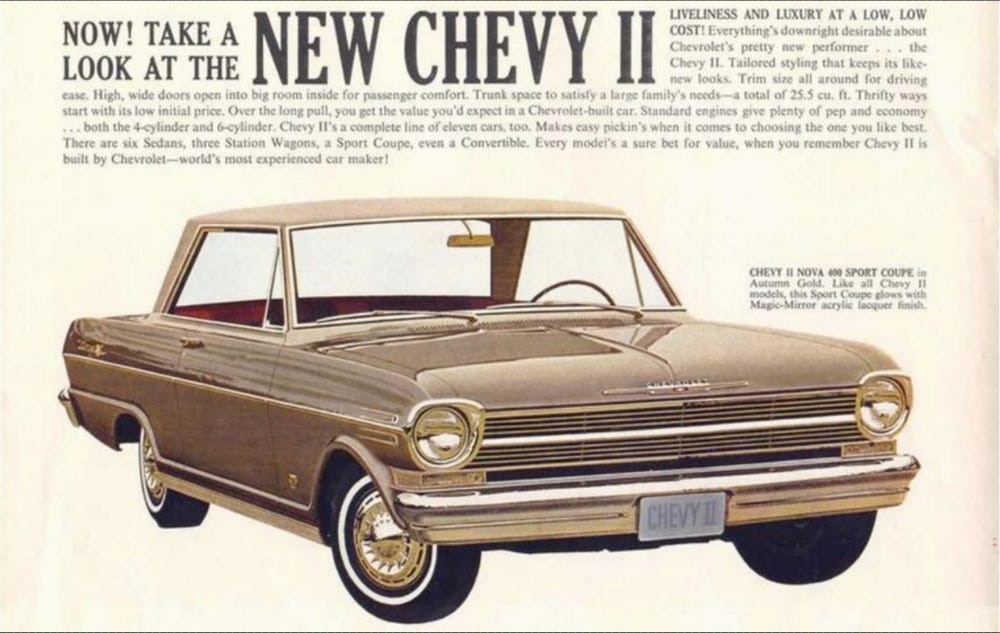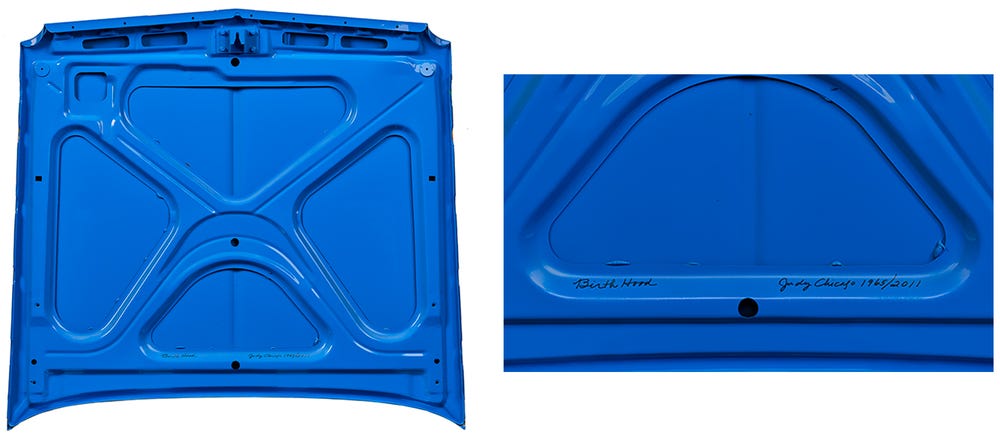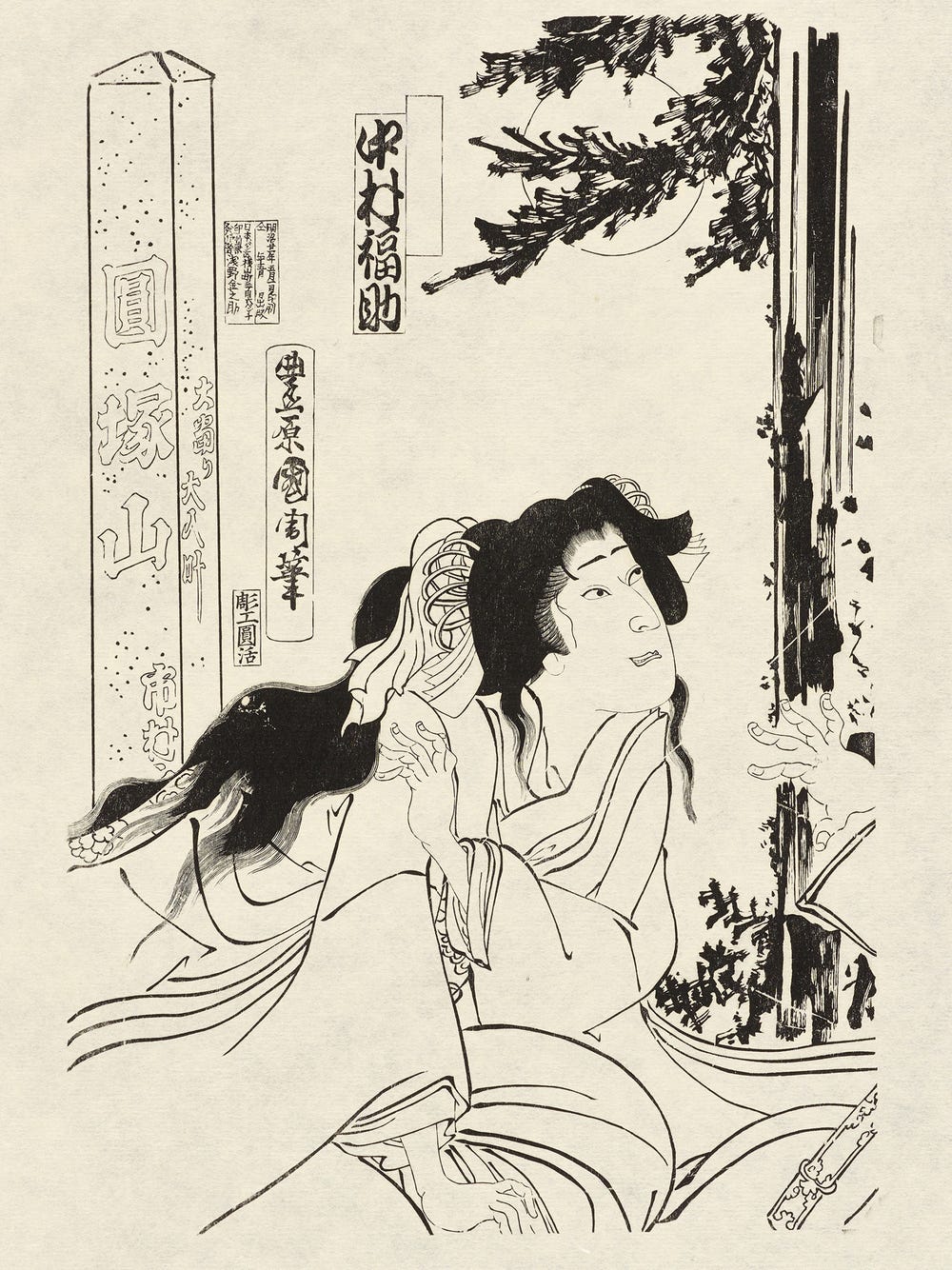Her Own Route: How Judy Chicago Turned Car Hoods into Art
By Jena Hirschbein
December 30, 2021
When it comes to materials, Judy Chicago is an artist without limits. Throughout her six-decade career, she has been known for many things but not for any one technique or medium. She has mastered skills in ceramics, metals, textiles, glass, plastics, paper, painting . . . even smoke.
Chicago is a powerhouse of ideas, both political and material. She works in and masters many media, and creates new ones. She may be best known for her work The Dinner Party, 1974 – 79. This important mixed-media installation is permanently on view at the Brooklyn Museum.
Judy Chicago, Birth Hood, 1965–2011. Sprayed automotive lacquer on car hood, 42 7/8 x 42 7/8 x 4 ¼ in. Fine Arts Museums of San Francisco, Foundation Purchase, Wattis Acquisition Endowment Fund, 2020.26.2.© 2021 Judy Chicago / Artists Rights Society (ARS), New York. Photography by Randy Dodson, © Fine Arts Museums of San Francisco
A perfect example of Chicago’s innovation is the recent Fine Arts Museums of San Francisco acquisition Birth Hood, 1965 – 2011. The piece was first created in 1965, around the time Chicago attended auto-body school. While in training there, she purchased new artist materials in the form of car hoods, and learned skills and techniques that would be used throughout her career. “I was always interested in fringe techniques,” she explains.
Installation view of the de Young’s Judy Chicago: A Retrospective, including Birth Hood, 1965–2011, and Rainbow Pickett, 1965, showing techniques and materials Chicago learned from auto body training in the 1960s. Photograph by Drew Altizer. Image courtesy of the Fine Arts Museums of San Francisco
Car art and perfectly polished finishes soon became staples of the male-dominated California art scene, but Chicago was among the first to use these techniques. Birth Hood was one of four such works she created at the time. The hood used was from a 1962 Chevy II. When asked “Why car hoods?” she responded, “I was in auto-body school and couldn’t relate to cars or car culture in any way, but I liked the shapes of the hoods.”
1967 Chevy II Nova buyer’s guide. Image courtesy of MotorTrend
Chicago prepared, primed, and painted the hoods to create wall-mounted objects that were part painting, part sculpture. She mastered taping and sanding automotive finishes to achieve clean lines and curves in the complex design of Birth Hood. Yet, even on the work’s immaculate finish, the artist’s hand is perceptible. Looking closely, one can enjoy small gestures and color relationships, as well as evidence of the artist’s methods — taping, painting, finishing, and polishing.
Judy Chicago, Birth Hood, 1965–2011 (Details). Sprayed automotive lacquer on car hood, 42 7/8 x 42 7/8 x 4 ¼ in. Fine Arts Museums of San Francisco, Foundation Purchase, Wattis Acquisition Endowment Fund, 2020.26.2. © 2021 Judy Chicago / Artists Rights Society (ARS), New York. Images courtesy of Jena Hirschbein
As a recent acquisition, Birth Hood joins a large and diverse collection. Conservators (among other staff) are responsible for its care. Whenever possible, conservators strive to understand the materials and methods used in an artwork, as well as the artist’s intention for the object and how they would like it displayed, stored, and cared for in the future. Birth Hood arrived in excellent condition and did not require any repair or treatment. However, in preparation for repairing damage on another of Chicago’s four car hoods, the Getty Conservation Institute conducted a scientific study in 2011. The Getty study provided important insight into Chicago’s working process that helped us better understand Birth Hood.
Chicago began Birth Hood by preparing the metal, likely smoothing and sanding any irregularities or damages to its surface. The Getty’s examination determined a polyvinyl acetate (PVA) primer was used on their hood, with a calcium carbonate (chalk) filler. Birth Hood likely has a similar primer layer between the bare metal and paint layers. Chicago used at least sixteen distinct paint colors on Birth Hood, creating immaculately clean lines and curves in a symmetrical design. She applied multiple layers of clear coat, a resin without pigment, to the paint so she could buff the surface to a high shine without damaging the design. Chicago recalls using airbrushes and spray guns she sourced from automotive suppliers for the work.
Birth Hood has two creation dates, 1965 and 2011. This is unusual, and we communicated with Chicago about what it means. According to the artist, work began on Birth Hood “in 1965 when it was primed and the image transferred to the hood. Only one of the four car hoods was completed at the time. The rest remained in storage until 2011, when I decided to finish them.” She continued, “I used whatever paint was available at the auto-body school . . . The paint formulations have changed since [from 1965 to 2011] because some acrylic lacquers have been banned in several states or have been otherwise regulated.”
The underside and signature of Birth Hood shows details consistent with a 1962 Chevy II, painted and clear coated. Fine Arts Museums of San Francisco, Foundation Purchase, Wattis Acquisition Endowment Fund, 2020.26.2 © 2021 Judy Chicago / Artists Rights Society (ARS), New York. Photography by Randy Dodson, © Fine Arts Museums of San Francisco
These days, as well as in 2011 when the work was finished, birth is a well-trodden topic of artistic self-expression. It’s difficult to imagine birth as a taboo theme. In 1965, however, birth was not a popular subject, even among feminist artists. When asked about this and the title of the work, Chicago responded, “I was 25 years old and the expectation was that I would get married and have a baby, and I was not interested in that. So I was wrestling with the subject of birth personally, which I took on philosophically and aesthetically later.”
Chicago’s take on birth in this work is perhaps as layered as her materials. What appears at first glance to be an artful design using shapes and simple figurative images is actually a provocative representation of a profound milestone in many women’s lives. Birth Hood can be seen as an attempt to transpose the mysterious and messy subject of birth onto the very male and mechanical language of the car. It is a skillful and subversive statement indeed.
Chicago has not been limited to any one medium in her career; rather she has been known for her courage and skill as an artist. Birth Hood is a record of this, and we are pleased to display this colorful and complex piece in the context of her life’s work and as a gem of our collection.
Judy Chicago, On Fire at 80, 2019. Archival Inkjet Print 24 x 30 1/8 in. (61 x 76.5 cm) © Judy Chicago/Artists Rights Society (ARS), New York Photo © Donald Woodman/ARS, New York Courtesy of the artist; Salon 94, New York; Jessica Silverman, San Francisco; and Cirrus Gallery, Los Angeles
Text by Jena Hirschbein, Assistant Objects Conservator at the Fine Arts Museums of San Francisco.
Judy Chicago: A Retrospective is on view at the de Young August 28, 2021 through January 9, 2022.












